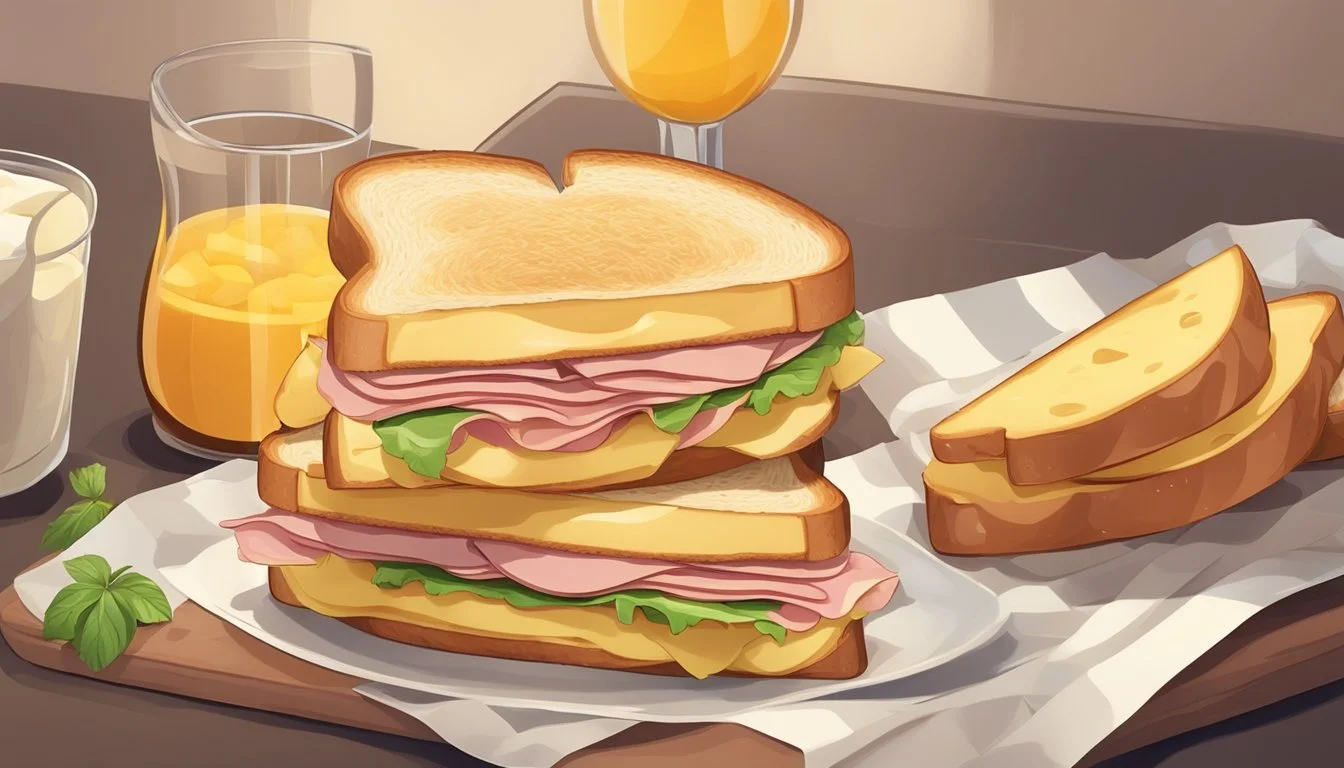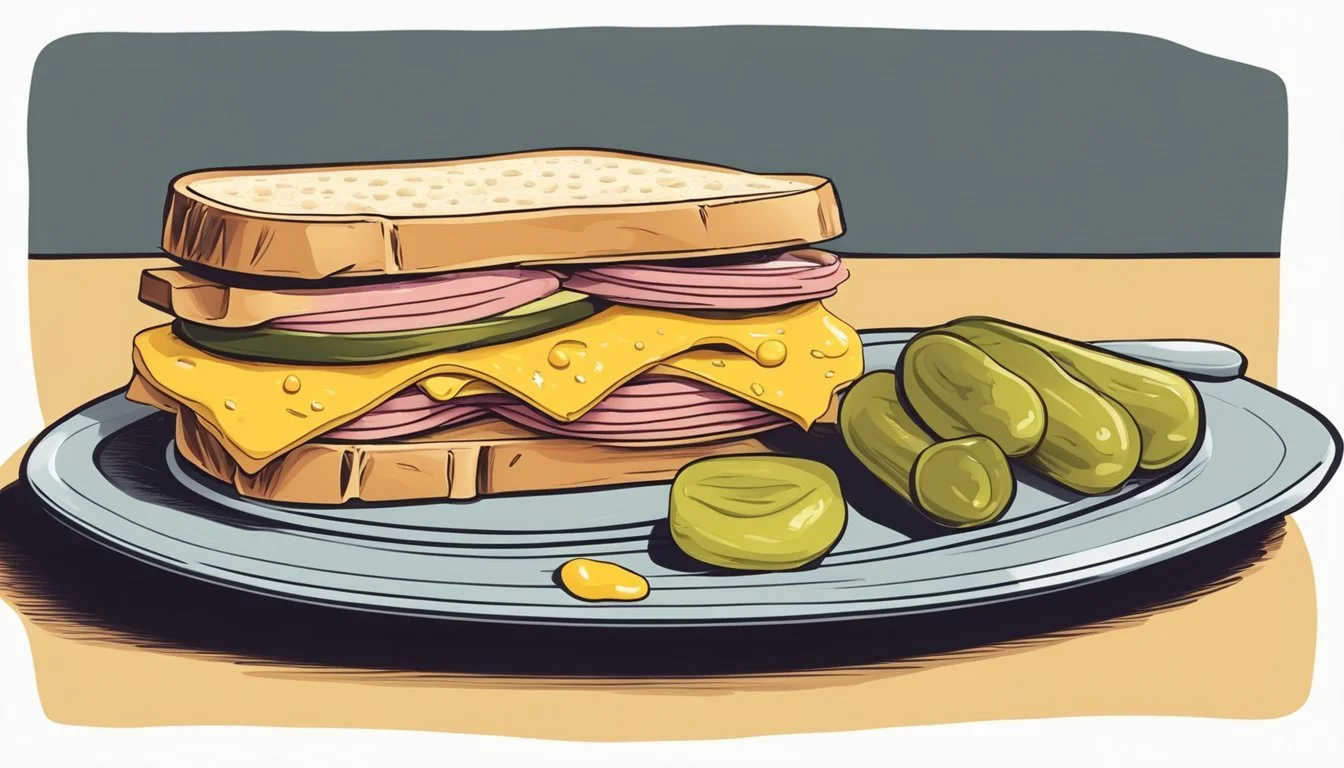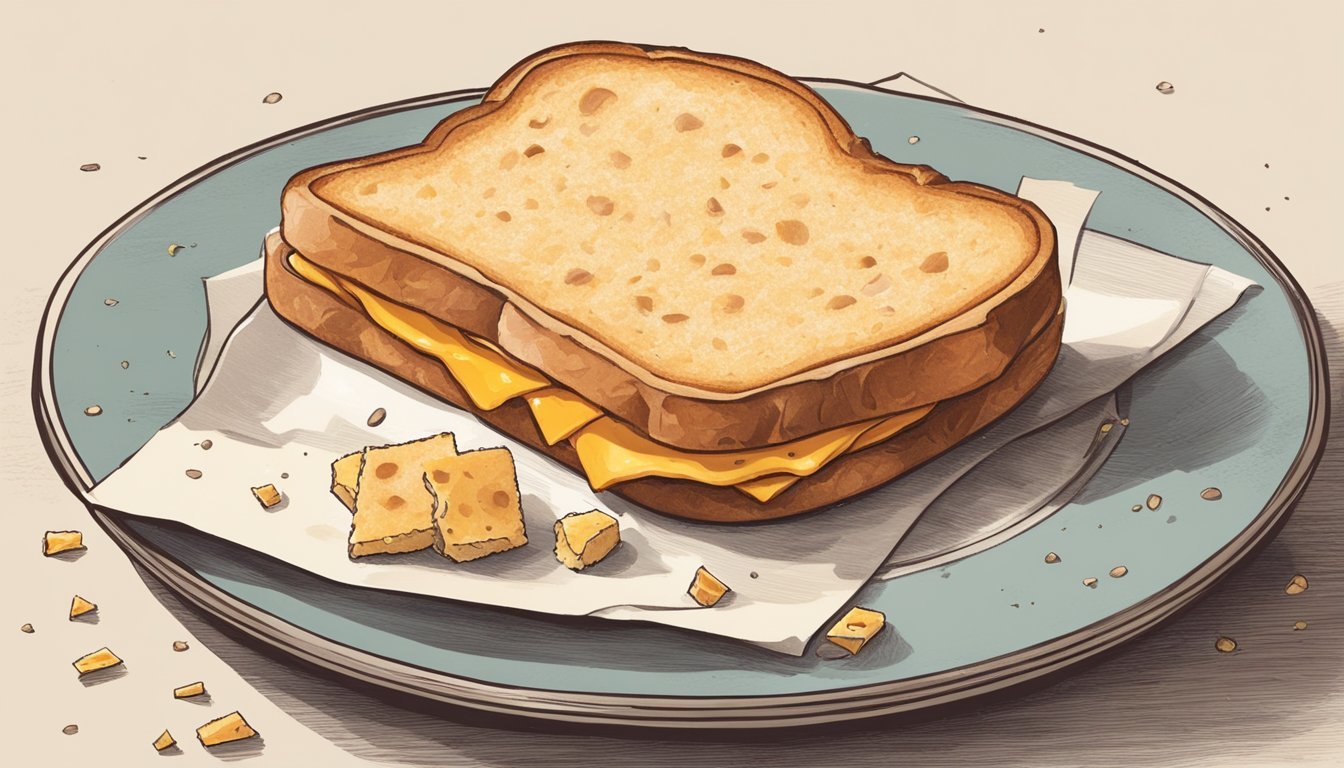How do you eat a ham and cheese sandwich?
Mastering the Art of Enjoying This Classic
Eating a ham and cheese (how long does cheese last?)sandwich might seem straightforward, but there’s a delightful array of options to consider that can transform this simple fare into a gourmet experience. From the choice of bread to the selection of condiments, each variation alters the flavor profile and texture of the sandwich. The simplicity of the recipe and the ubiquity of the ingredients have made the ham and cheese sandwich a beloved classic worldwide.
To craft the ideal sandwich, one begins with quality ingredients. Selecting a preferred type of ham, ranging from honey-glazed to smoked, and pairing it with a complementary cheese, such as Swiss, cheddar, or Gruyere, lays the foundation. The bread acts as a canvas, whether it's a crusty baguette or a soft brioche, and it could be lightly toasted or generously buttered to achieve a golden crunch.
The instructions for constructing the sandwich offer room for personalization. Layering techniques, such as folding the ham to add volume or distributing the cheese evenly for optimal melting, can enhance the eating experience. Additionally, one may opt for a touch of mustard, mayonnaise, or a spread of fig jam to introduce a hint of complexity to this uncomplicated yet satisfying meal.
Choosing Ingredients
When creating a ham and cheese sandwich, selecting quality ingredients is critical to enhancing its flavor and texture. The choice of bread, type of ham, variety of cheese, and additional fillings can transform a simple sandwich into a gourmet lunch (What wine goes well with lunch?) experience.
Selecting the Right Bread
The foundation of a ham and cheese sandwich is the bread. It should be sturdy enough to hold the weight of the fillings.
White Bread: Classic and soft, ideal for a simple, traditional sandwich.
Sourdough Bread: Offers a tangy flavor and crisp texture when toasted.
Wheat Bread: A healthier option that provides an earthy taste and extra fiber.
Artisan Breads: Such as ciabatta or a baguette, contribute unique flavors and textures.
English Muffins/Croissants: Provide a creative twist and buttery layers.
Types of Ham
The ham is the protein staple that defines the sandwich.
Deli Ham: Convenient, thinly sliced, and works well for a quick lunch.
Spiral Ham: Adds a festive and richer flavor profile, typically pre-cooked with a glaze.
Black Forest Ham: Smoked and seasoned for a deep, woodsy flavor.
Honey Ham: Combines sweetness with the savory aspect of ham.
Peppered Ham: Offers a spicy kick for those who favor bolder tastes.
Varieties of Cheese
Cheese adds a layer of flavor and creamy texture.
Cheddar: Sharp and robust, melts well.
Swiss Cheese: Known for its mild nuttiness and ability to complement ham.
Provolone: Provides a smooth texture and harmonizes with various ham types.
Gruyere: A more sophisticated choice that melts beautifully with a distinctive taste.
Monterey Jack/Mozzarella: Milder options that allow the flavor of the ham to shine.
Additional Fillings and Condiments
Extra layers can enhance complexity and balance.
Butter: Creates a golden crust when grilling.
Mustards (Dijon, Honey Mustard): Offer a tangy sharpness or a sweet and tangy flavor.
Mayo: Adds creaminess.
Pickles/Onions/Tomatoes/Avocado: Fresh vegetables complement the salty ham and rich cheese.
Béchamel Sauce: Although not common, it enriches the sandwich with a velvety texture.
Herbs and Spices
Herbs and spices should be used judiciously to elevate the sandwich without overpowering it.
Freshly ground black pepper or a dash of horseradish can introduce a subtle heat.
To infuse an aromatic touch, consider adding basil, oregano, or thyme.
Preparation Techniques
Creating a satisfying ham and cheese sandwich involves a series of steps that can influence both the texture and flavor of the final product. Various techniques in the preparation process can ensure a delicious outcome.
Slicing and Layering Components
Sliced ham should be thin to allow for even cooking and layering. A typical pattern involves layering the ham between slices of cheese to provide good melting characteristics and flavor distribution. Slices of bread act as the foundational component, holding the sandwich together.
Spreading Condiments
A thin spread of mayo, Dijon mustard, or honey mustard on the bread slices adds moisture and flavor. The key is to apply just enough to complement, not overpower, the taste of the ham and cheese.
Grilling Methods
One can use a grill or skillet for cooking. For a skillet, one can preheat it over a medium heat, then cook the sandwich for 2-3 minutes per side until the bread is toasted and the cheese melted. When using a grill, ensure it's well-oiled and at a moderate temperature to avoid burning.
Baking Alternatives
For those preferring an oven-baked sandwich, the broiler or oven can be preheated and the sandwich baked until the cheese is bubbling and the exterior crisp. This method is particularly useful for making multiple sandwiches (What wine goes well with sandwiches?) at once.
Utilizing Leftovers
One can incorporate leftover ham into the sandwich as an efficient and tasty way to repurpose leftovers from previous meals. It should be sliced or cut to fit the sandwich accordingly and can enhance the overall flavor profile.
Making in Advance
For those planning, a ham and cheese sandwich can be prepared in advance and stored in the refrigerator or frozen. When ready to eat, ensure the sandwich is thawed thoroughly before being heated through to achieve the desired texture and warmth.
Cooking the Sandwich
Cooking a ham and cheese sandwich to perfection involves several key techniques such as proper heat application and ingredient selection. The aim is to melt the cheese evenly, achieve a golden and crispy texture, and maintain a balance between taste and health.
Stovetop Grilling
To grill a ham and cheese sandwich on the stovetop, begin by heating a skillet over medium heat. Butter one side of each bread slice, then place one slice butter-side down onto the skillet. Layer on the cheese, followed by thinly folded ham slices to promote even cooking. Place the second slice of bread on top, buttered side up. Grill until the first side is golden brown, then flip carefully to grill the other side.
Oven Baking
Baking a ham and cheese sandwich in the oven is a fuss-free alternative to stovetop grilling. Preheat your oven to 350°F (175°C) or use a broiler for a quicker option. Assemble the sandwich with the desired amount of cheese and ham between two slices of bread, and place it in the oven. Bake until the cheese has melted thoroughly and the bread turns crispy and golden brown.
Ensuring Cheese Melts Evenly
The key to melted cheese in a sandwich is using thin slices or grated cheese for quicker and more even melting. Swiss or Gruyere cheese are excellent melting cheeses that add a rich flavour to your sandwich. Layer the cheese evenly across the bread to prevent any unmelted patches.
Achieving the Perfect Crisp
A perfect crisp on a ham and cheese sandwich requires using a buttered skillet or baking until the bread is golden brown. The butter acts as a crisping agent, providing a delectable texture contrast to the melted cheese. Monitor the sandwich carefully as it cooks to ensure it does not burn.
Keeping It Healthy
While ham and cheese sandwiches are comfort food, they can still be part of a balanced diet. Opt for whole-grain bread, add slices of avocado for healthy fats, or choose a leaner cut of ham to reduce calorie intake. Consider serving with a side of salad to incorporate more vegetables into your lunch or dinner.
The choice of cooking method and ingredients can transform the humble ham and cheese sandwich into either a simple lunchbox staple or an indulgent main course. Using these techniques, anyone can cook a delicious grilled ham and cheese sandwich at home.
Serving Suggestions
When choosing accompaniments for a ham and cheese sandwich, one should consider the balance and variety to complement both lunch and dinner settings.
Choosing Sides
For a satisfying lunch, classic potato chips or french fries serve as a crunchy counterpoint to the soft bread and melted cheese. Alternatively, a side salad with a vinaigrette dressing can offer a refreshing contrast to the richness of the sandwich. A popular choice is a broccoli salad, often combined with cranberries, grapes, bacon, and almonds for a mix of sweet and savory notes.
Pairing with Soup
During colder months or for a heartier dinner, pairing a ham and cheese sandwich with soup is ideal. Split pea soup is a traditional accompaniment. The earthiness of the peas and the smoky flavor of ham make a cohesive pairing. For those preferring something lighter, a tomato soup can also be a delightful choice, providing a touch of acidity that balances the sandwich's flavors.
Preparation for Lunchboxes
For a portable lunchbox meal, one might prepare the ham and cheese sandwich with a less soggy preparation, using a hearty type of bread and packing condiments separately. Accompany it with a small side salad or fresh vegetables like carrot sticks or cucumber slices for a healthy option that maintains texture until eaten.
Dinner Presentation
As a main course for dinner, presentation plays a crucial role. One could serve the sandwich with a garnish, such as a pickle spear or olive, on a platter beside a serving of homemade mozzarella sticks or sweet potato wedges. Arranging these sides in an appealing manner makes the meal inviting and rounds out the dining experience.
Recipe Variations
Exploring different recipe variations for ham and cheese sandwiches can transform this traditional lunchtime staple into a culinary delight. From the addition of gourmet ingredients to satisfying dietary restrictions, here are ways to reinvent the classic ham and cheese.
Alternative Sandwich Recipes
One might swap traditional white bread for croissants (how long do croissants last?) or sourdough, lending a buttery richness or tangy bite to the sandwich. The Croque Monsieur, a French bistro classic involving ham, gruyere, and béchamel sauce, serves as an indulgent take on the hot ham and cheese sandwich.
Adding a Gourmet Twist
For a gourmet twist, layering in slices of avocado or using high-quality artisanal hams can elevate the sandwich. Replacing common cheddar with gruyère cheese and adding a spoonful of béchamel sauce before grilling can turn a simple sandwich into a luxurious meal.
Customizing for Dietary Restrictions
Those with dietary restrictions can use gluten-free bread or low-fat turkey as a protein replacement for ham. One could also use dairy-free cheese alternatives or leaner meats to craft a sandwich that complies with dietary needs without sacrificing flavor.
Spicing Things Up
To introduce a bit of spice and zest, incorporating condiments like spicy horseradish or a bright splash of lime can add a tangy punch. These flavors can transform a standard grilled ham and cheese into a sandwich with a delightful kick.
Tips and Tricks
In creating the perfect ham and cheese sandwich, one should consider strategies to manage moisture, temperature control, portability, and taste optimization.
How to Prevent Sogginess
To avoid a soggy sandwich, butter should be applied to the outside of the bread. This protective layer helps to create a barrier between the bread and moist ingredients. For the interior, a thin layer of mayonnaise or other condiments can act as a sealant to keep moisture from the ham and cheese from seeping into the bread.
Keeping the Sandwich Warm
Maintaining the warmth of a ham and cheese sandwich is crucial, especially if it’s meant to be enjoyed hot. After cooking, the sandwich can be wrapped in aluminum foil to retain heat. Keeping it on a warm but not hot surface, like a turned-off stove, can also help it stay warm until serving.
Packing for To-Go Meals
For those looking to pack a ham and cheese sandwich for a lunchbox, wrapping the sandwich in parchment paper can be effective. It allows the sandwich to breathe, preventing condensation that can lead to sogginess. Adding a thermal container to the lunchbox can help maintain the desired temperature, warm or cold.
Getting the Best Flavor Balance
To achieve the best flavor balance, one must consider the flavors of the condiments and how they complement the ham and cheese. A recipe might suggest a harmonious amount of mayonnaise or mustard. Additionally, choosing a cheese that melts well can ensure that each bite is rich and full of texture. Using quality ingredients and layering them properly according to instructions can elevate the overall taste experience.
Conclusion
Eating a ham and cheese sandwich can be a satisfying experience with its simple combination of flavors making it a classic main course or comfort food. The basic recipe offers a foundation that welcomes variation, thus catering to a wide array of palates. It's an easy and quick solution for a fulfilling meal.
To optimize the taste and texture, they should consider the quality of the ingredients. For example, selecting high-quality ham and a cheese that melts well can significantly enhance the overall flavor. Complementing the sandwich with condiments or additional toppings allows for personalization. The following are some notes to remember:
Bread: Choose a type that holds up well when grilled and complements the saltiness of the ham.
Ham: Quality matters, and whether one opts for honey ham, smoked, or turkey ham, it should be sliced to the right thickness.
Cheese: Varieties such as Swiss, cheddar, or Gouda offer distinct flavors and melting characteristics.
Cooking Method: Toasting or grilling the sandwich adds texture and warmth, elevating it beyond a simple cold sandwich.
Many enjoy customizing the base recipe by adding ingredients like tomatoes, spinach, or a spread of their choice. A good ham and cheese sandwich is adaptable, quick to prepare, and comfortably crosses the line from a simple snack to an enjoyable meal at any time of the day.
Supplemental Information
In this section, readers will gain a deeper understanding of the ham and cheese sandwich beyond the basic recipe. From its nutritional value to cultural relevance and more, the details provided aim to enhance the overall sandwich experience.
Nutritional Information
A typical ham and cheese sandwich consists of protein sourced from both ham and cheese, contributing to the sandwich’s energy-yielding attributes. Generally, it contains approximately:
Calories: 300-400 kcal
Proteins: 15-25g
Carbohydrates: 30-40g (with fiber content around 4.5g)
Fats: 15-20g
Sodium: 700-800mg
Potassium: 200-300mg
It's important to consider variations in ingredient types and quantities for specific nutritional values.
Cultural Significance of Ham and Cheese Sandwiches
The ham and cheese sandwich is recognized worldwide as a staple comfort food. It's often associated with home cooking and can evoke nostalgia, with many people recalling it as a simple yet satisfying meal prepared by their mom or within families.
Food Photography Tips
Food photographers aiming to capture the essence of a ham and cheese sandwich should focus on the textures and layers. Using natural light and choosing a good angle can emphasize the gooeyness of the cheese and the heartiness of the ham.
Incorporating Feedback in the Kitchen
When refining a ham and cheese sandwich recipe, it’s beneficial to incorporate feedback from taste-testers. Adjusting the amount of ham or cheese, or even the type of bread used, based on feedback, can significantly improve the final product.
Historical Context of Sandwich Creation
Sandwiches, as a concept, were popularized in the 18th century by the Earl of Sandwich. They have since evolved into various forms, including the beloved ham and cheese sandwich, which has cemented its place as a quick and easy meal option over the centuries.
How-to Videos for Visual Learners
For those who prefer a visual aid, how-to videos can be a great resource. They provide step-by-step instructions on crafting the perfect ham and cheese sandwich, ensuring that even culinary beginners can achieve good results by following along.
Frequently Asked Questions
This section addresses common inquiries about preparing and preserving ham and cheese sandwiches, ensuring a delightful culinary experience.
What Bread Goes Best with Ham and Cheese?
The choice of bread significantly affects the texture and taste of a ham and cheese sandwich. Artisan bread, wheat bread, and sourdough bread are excellent choices for their robust texture and ability to complement the flavors of the fillings. For a buttery, flaky alternative, one might consider using a croissant.
Which Cheese Should I Use for a Melty Middle?
For a cheese that melts beautifully and provides a creamy texture, consider cheddar, Swiss, provolone, gruyere, or Monterey Jack. Each cheese has a distinct flavor profile ranging from nutty to sharp, catering to personal preferences.
How to Cook the Sandwich without a Grill?
One can prepare a ham and cheese sandwich without a grill by using a skillet or oven. In a skillet, cook the sandwich on medium heat until each side is golden brown. If using an oven, one may bake the sandwich until the cheese is appropriately melted and the bread reaches the desired crispiness.
Can Ham and Cheese Sandwiches Be Frozen?
Sandwiches can be prepared in advance and kept frozen for convenience. To freeze, wrap each sandwich individually and store it in a freezer-safe bag. When ready to consume, one can thaw the sandwich and then heat it in a skillet, oven, or toaster until warmed through and the cheese has melted.







